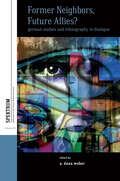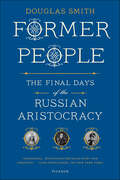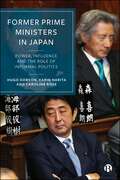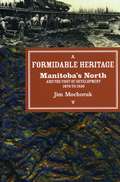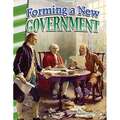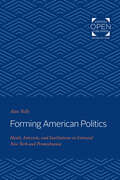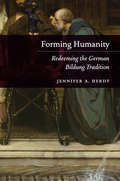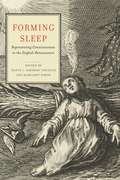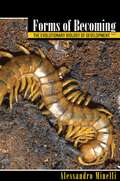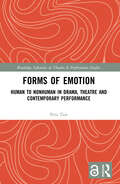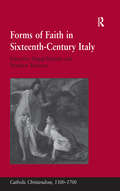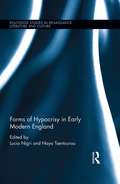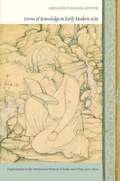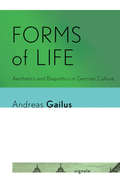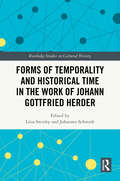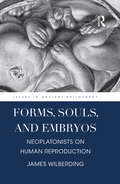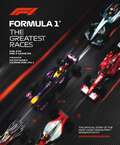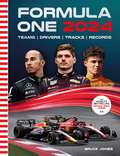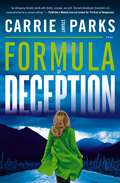- Table View
- List View
Former Neighbors, Future Allies?: German Studies and Ethnography in Dialogue (Spektrum: Publications of the German Studies Association #28)
by Dana WeberGerman studies scholars from various disciplines often use and reference ethnography, yet do not often present ethnography as a core methodology and research approach. Former Neighbors, Future Allies? emphasizes how German studies engages in methods and theories of ethnography. Through a variety of topics and from multiple perspectives including literature, folklore, history, sociology, and anthropology, this volume draws attention to how ethnography bridges transdisciplinary and international research in German studies.
Former People: The Final Days of the Russian Aristocracy
by Douglas SmithEpic in scope, precise in detail, and heart-breaking in its human drama, Former People is the first book to recount the history of the aristocracy caught up in the maelstrom of the Bolshevik Revolution and the creation of Stalin's Russia. Filled with chilling tales of looted palaces and burning estates, of desperate flights in the night from marauding peasants and Red Army soldiers, of imprisonment, exile, and execution, it is the story of how a centuries'-old elite, famous for its glittering wealth, its service to the Tsar and Empire, and its promotion of the arts and culture, was dispossessed and destroyed along with the rest of old Russia.Yet Former People is also a story of survival and accommodation, of how many of the tsarist ruling class—so-called "former people" and "class enemies"—overcame the psychological wounds inflicted by the loss of their world and decades of repression as they struggled to find a place for themselves and their families in the new, hostile order of the Soviet Union. Chronicling the fate of two great aristocratic families—the Sheremetevs and the Golitsyns—it reveals how even in the darkest depths of the terror, daily life went on. Told with sensitivity and nuance by acclaimed historian Douglas Smith, Former People is the dramatic portrait of two of Russia's most powerful aristocratic families, and a sweeping account of their homeland in violent transition.
Former Prime Ministers in Japan: Power, Influence and the Role of Informal Politics
by Caroline Rose Hugo Dobson Karin NaritaAvailable open access digitally under CC-BY-NC-ND licence. Despite growing international interest in the position and power of the Japanese prime minister, there is little existing research on what happens after these figures leave office. Examining both pre-war and post-war Japan, this book investigates what Japanese prime ministers have done after stepping down and what influence they have continued to exert. Based on research in English and Japanese including biographies, memoirs and interviews, the book examines the specific activities former prime ministers engage in, assessing their motivations and the effect of informal politics in Japan on their successes and failures. Ultimately, the book answers the simple but often unanswered question of ‘where are they now’ and writes the unwritten post-resignation biographies of Japan’s prime ministers.
Formidable Heritage: Manitoba's North and the Cost of Development
by Jim MochorukCanadians have an ambivalent feeling towards the North. Although climate and geography make our northern condition apparent, Canadians often forget about the north and its problems. Nevertheless, for the generation of historians that included Lower, Creighton, and Morton, the northern rivers, lakes, forests, and plains were often seen as primary characters in the drama of nation building. W.L. Morton even went so far as to write that the ìmain task of Canadian life has been to make something of that formidable heritageî of the northern Canadian shield. For many politicians and developers, "to make something" of the North came to mean thinking of the North as an empty hinterland waiting to be exploited, and today, hydroelectric projects, mining, milling, pulp and paper, and other industries have changed much of the North beyond recognition.One of the first parts of the North to be aggressively industrialized was northern Manitoba. When all of Manitoba was given in 1670 to a group of entrepreneurs, a precedent was set that was replicated throughout the provinceís history. After the province entered confederation in 1870, provincial politicians and business leaders began to look to the northern resources as a new key to the provinceís economic development. Particularly after 1912, they saw resource development in the North as a strategy to expand the provincial economy from its agricultural base. Jim Mochoruk shows how government and business worked together to transform what had been the exclusive fur-trading preserve of the Hudsonís Bay Company into an industrial hinterland. He follows the many twisting paths established by developers and politicians as they chased their goal of economic growth, and recounts the ultimate costs of development in economic, ecological, and political terms.
Formidable: American Women and the Fight for Equality: 1920-2020
by Elisabeth Griffith&“An essential history of the struggle by both Black and white women to achieve their equal rights.&”—Hillary Rodham ClintonThe Nineteenth Amendment was an incomplete victory. Black and white women fought hard for voting rights and doubled the number of eligible voters, but the amendment did not enfranchise all women, or even protect the rights of those women who could vote. A century later, women are still grappling with how to use the vote and their political power to expand civil rights, confront racial violence, improve maternal health, advance educational and employment opportunities, and secure reproductive rights. Formidable chronicles the efforts of white and Black women to advance sometimes competing causes. Black women wanted the rights enjoyed by whites. They wanted to protect their communities from racial violence and discrimination. Theirs was not only a women&’s movement. White women wanted to be equal to white men. They sought equal legal rights, political power, safeguards for working women and immigrants, and an end to confining social structures. There were also many white women who opposed any advance for any women. In this riveting narrative, Dr. Elisabeth Griffith integrates the fight by white and Black women to achieve equality. Previously their parallel struggles for social justice have been presented separately—as white or Black topics—or covered narrowly, through only certain individuals, decades, or incidents. Formidable provides a sweeping, century-long perspective, and an expansive cast of change agents. From feminists and civil rights activists to politicians and social justice advocates, from working class women to mothers and homemakers, from radicals and conservatives to those who were offended by feminism, threatened by social change, or convinced of white supremacy, the diversity of the women&’s movement mirrors America. After that landmark victory in 1920, suffragists had a sense of optimism, declaring, &“Now we can begin!&” By 2020, a new generation knew how hard the fight for incremental change was; they would have to begin again. Both engaging and outraging, Formidable will propel readers to continue their foremothers&’ fights to achieve equality for all.
Forming A New Government (Social Studies: Informational Text Series)
by Stephanie ParisThe Primary Source Readers series will ignite students' interest in history through the use of intriguing primary sources. Students will learn about the vital period of American history following the colonies' decision to establish a new government, and covers crucial topics like the Constitution of the United States and the Bill of Rights. This nonfiction reader features purposefully leveled text to increase comprehension for different learner types. Text features include captions, a glossary, and an index to help build academic vocabulary and increase reading comprehension and literacy. This book prepares students for college and career readiness and aligns with state standards including NCSS/C3, McREL, and WIDA/TESOL.
Forming American Politics: Ideals, Interests, and Institutions in Colonial New York and Pennsylvania
by Alan TullyOriginally published in 1994. In this pathbreaking book Alan Tully offers an unprecedented comparative study of colonial political life and a rethinking of the foundations of American political culture. Tully chooses for his comparison the two colonies that arguably had the most profound impact on American political history—New York and Pennsylvania, the rich and varied colonies at the geographical and ideological center of British colonial America.Fundamental to the book is Tully's argument that out of Anglo-American influences and the cumulative character of each colonial experience, New York and Pennsylvania developed their own distinctive but complementary characteristics. In making this case Tully enters—from a new perspective—the prominent argument between the "classical republican" and "liberal" views of early American public thought. He contends that the radical Whig element of classical republicanism was far less influential than historians have believed and that the political experience of New York and Pennsylvania led to their role as innovators of liberal political concepts and discourse. In a conclusion that pursues his insights into the revolutionary and early republican years, Tully underlines a paradox in American political development: not only were the pathbreaking liberal politicians of New York and Pennsylvania the least inclined towards revolutionary fervor, but their political language and concepts—integral to an emerging liberal democratic order—were rooted in oligarchical political practice."A momentous contribution to the burgeoning literature on the middle Atlantic region, and to the vexed question of whether it constitutes a coherent cultural configuration. Tully argues persuasively that it does, and his arguments will have to be reckoned with like few that have gone before, even as he develops an array of differences between the two colonies more subtle and penetrating than any of his predecessors has ever put forth."—Michael Zuckerman, University of Pennsylvania.
Forming Humanity: Redeeming the German Bildung Tradition
by Jennifer A. HerdtNow in paperback, Forming Humanity reveals bildung, or ethical formation, as the key to post-Kantian thought. Kant’s proclamation of humankind’s emergence from “self-incurred immaturity” left his contemporaries with a puzzle: What models should we use to sculpt ourselves if we no longer look to divine grace or received authorities? Deftly uncovering the roots of this question in Rhineland mysticism, Pietist introspection, and the rise of the bildungsroman, Jennifer A. Herdt reveals bildung, or ethical formation, as the key to post-Kantian thought. This was no simple process of secularization, in which human beings took responsibility for something they had earlier left in the hands of God. Rather, theorists of bildung, from Herder through Goethe to Hegel, championed human agency in self-determination while working out the social and political implications of our creation in the image of God. While bildung was invoked to justify racism and colonialism by stigmatizing those deemed resistant to self-cultivation, it also nourished ideals of dialogical encounter and mutual recognition. Herdt reveals how the project of forming humanity lives on in our ongoing efforts to grapple with this complicated legacy.
Forming Sleep: Representing Consciousness in the English Renaissance (Cultural Inquiries in English Literature, 1400–1700 #2)
by Nancy L. Simpson-Younger Margaret SimonForming Sleep asks how biocultural and literary dynamics act together to shape conceptions of sleep states in the early modern period. Engaging with poetry, drama, and prose largely written in English between 1580 and 1670, the essays in this collection highlight period discussions about how seemingly insentient states might actually enable self-formation.Looking at literary representations of sleep through formalism, biopolitics, Marxist theory, trauma theory, and affect theory, this volume envisions sleep states as a means of defining the human condition, both literally and metaphorically. The contributors examine a range of archival sources—including texts in early modern faculty psychology, printed and manuscript medical treatises and physicians’ notes, and printed ephemera on pathological sleep—through the lenses of both classical and contemporary philosophy. Essays apply these frameworks to genres such as drama, secular lyric, prose treatise, epic, and religious verse. Taken together, these essays demonstrate how early modern depictions of sleep shape, and are shaped by, the philosophical, medical, political, and, above all, formal discourses through which they are articulated. With this in mind, the question of form merges considerations of the physical and the poetic with the spiritual and the secular, highlighting the pervasiveness of sleep states as a means by which to reflect on the human condition. In addition to the editors, the contributors to this volume include Brian Chalk, Jennifer Lewin, Cassie Miura, Benjamin Parris, Giulio Pertile, N. Amos Rothschild, Garret A. Sullivan Jr., and Timothy A. Turner.
Forming Sleep: Representing Consciousness in the English Renaissance (Cultural Inquiries in English Literature, 1400–1700)
by Nancy L. Simpson-Younger Margaret SimonForming Sleep asks how biocultural and literary dynamics act together to shape conceptions of sleep states in the early modern period. Engaging with poetry, drama, and prose largely written in English between 1580 and 1670, the essays in this collection highlight period discussions about how seemingly insentient states might actually enable self-formation.Looking at literary representations of sleep through formalism, biopolitics, Marxist theory, trauma theory, and affect theory, this volume envisions sleep states as a means of defining the human condition, both literally and metaphorically. The contributors examine a range of archival sources—including texts in early modern faculty psychology, printed and manuscript medical treatises and physicians’ notes, and printed ephemera on pathological sleep—through the lenses of both classical and contemporary philosophy. Essays apply these frameworks to genres such as drama, secular lyric, prose treatise, epic, and religious verse. Taken together, these essays demonstrate how early modern depictions of sleep shape, and are shaped by, the philosophical, medical, political, and, above all, formal discourses through which they are articulated. With this in mind, the question of form merges considerations of the physical and the poetic with the spiritual and the secular, highlighting the pervasiveness of sleep states as a means by which to reflect on the human condition. In addition to the editors, the contributors to this volume include Brian Chalk, Jennifer Lewin, Cassie Miura, Benjamin Parris, Giulio Pertile, N. Amos Rothschild, Garret A. Sullivan Jr., and Timothy A. Turner.
Forms of Becoming: The Evolutionary Biology of Development
by Alessandro MinelliWhat comes first, form or function? Trumpeted as the future of biological science, evolutionary developmental biology (or "evo-devo") answers this fundamental question by showing how evolution controls the development of organisms. In Forms of Becoming, Alessandro Minelli, a leading international figure in the field, takes an in-depth and comprehensive look at the history and key issues of evo-devo. Spirited and insightful, this book focuses on the innovative ways animal organisms evolve through competition and cooperation. Minelli provides a complete overview of conceptual developments--from the fierce nineteenth-century debates between the French biologists Geoffroy and Cuvier, who fought over questions of form versus function--to modern theories of how genes dictate body formation. The book's wide-ranging topics include expression patterns of genes, developmental bias, the role of developmental genes, and genetic determinism. Drawing from diverse examples, such as the anatomy of butterflies, giraffes, Siamese twins, and corals, Minelli extends and reformulates important concepts from development, evolution, and the interplay between the two. Presenting the accessible and cutting-edge ideas of evolutionary developmental biology, Forms of Becoming is fascinating reading for anyone interested in genetics and the animal form.
Forms of Dominance: On the Architecture and Urbanism of the Colonial Enterprise (Routledge Library Editions: Ethnoscapes)
by Nezar AlSayyadOriginally published in 1992, as part of the Ethnoscapes: Current Challenges in the Environmental Social Sciences series, reissued now with a new series introduction and new preface, Forms of Dominance: On the Architecture and Urbanism of the Colonial Enterprise examines the complex experience of colonial domination, social reaction, and physical adaptation within the built environment of regions such as Morocco, Eastern Europe, India, Guatemala and East Africa, and provides a multi-disciplinary and cross-cultural perspective on the colonial experience.
Forms of Emotion: Human to Nonhuman in Drama, Theatre and Contemporary Performance (Routledge Advances in Theatre & Performance Studies)
by Peta TaitForms of Emotion analyses how drama, theatre and contemporary performance present emotion and its human and nonhuman diversity. This book explores the emotions, emotional feelings, mood, and affect, which make up a spectrum of ‘emotion’, to illuminate theatrical knowledge and practice and reflect the distinctions and debates in philosophy, neuroscience, psychology, and other disciplines. This study asserts that specific forms of emotion are intentionally unified in drama, theatre, and performance to convey meaning, counteract separation and subversively champion emotional freedom. The book progressively shows that the dramatic and theatrical representation of the nonhuman reveals how human dominance is offset by emotional connection with birds, animals, and the natural environment. This book will be of great interest to students and researchers interested in the emotions and affect in dramatic literature, theatre studies, performance studies, psychology, and philosophy as well as artists working with emotionally expressive performance.
Forms of Ethical and Intellectual Development in the College Years: A Scheme
by William G. PerrySince its original publication in 1970, this landmark book by William Perry has remained the cornerstone of much of the student development research that followed. Using research conducted with Harvard undergraduates over a fifteen-year period, Perry derived an enduring framework for characterizing student development--a scheme so accurate that it still informs and advances investigations into student development across genders and cultures. Drawing from firsthand accounts, Perry traces a path from students' adolescence into adulthood. His nine-stage model describes the steps that move students from a simplistic, categorical view of knowledge to a more complex, contextual view of the world and of themselves. Throughout this journey of cognitive development, Perry reveals that the most significant changes occur in forms in which people perceive their world rather than in the particulars of their attitudes and concerns. He shows ultimately that the nature of intellectual development is such that we should pay as much attention to the processes we use as to the content. In a new introduction to this classic work, Lee Knefelkamp--a close colleague of Perry's and a leading expert on college student development--evaluates the book's place in the literature of higher education. Knefelkamp explains how the Perry scheme has shaped current thinking about student development and discusses the most significant research that has since evolved from Perry's groundbreaking effort. Forms of Ethical and Intellectual Development in the College Years is a work that every current and future student services professional must have in their library.
Forms of Faith in Sixteenth-Century Italy (Catholic Christendom, 1300-1700)
by Matthew TreherneThe sixteenth century was a period of tumultuous religious change in Italy as in Europe as a whole, a period when movements for both reform and counter-reform reflected and affected shifting religious sensibilities. Cinquecento culture was profoundly shaped by these religious currents, from the reform poetry of the 1530s and early 1540s, to the efforts of Tridentine theologians later in the century to renew Catholic orthodoxy across cultural life. This interdisciplinary volume offers a carefully balanced collection of essays by leading international scholars in the fields of Italian Renaissance literature, music, history and history of art, addressing the fertile question of the relationship between religious change and shifting cultural forms in sixteenth-century Italy. The contributors to this volume are throughout concerned to demonstrate how a full understanding of Cinquecento religious culture might be found as much in the details of the relationship between cultural and religious developments, as in any grand narrative of the period. The essays range from the art of Cosimo I's Florence, to the music of the Confraternities of Rome; from the private circulation of religious literature in manuscript form, to the public performances of musical laude in Florence and Tuscany; from the art of Titian and Tintoretto to the religious poetry of Vittoria Colonna and Torquato Tasso. The volume speaks of a Cinquecento in which religious culture was not always at ease with itself and the broader changes around it, but was nonetheless vibrant and plural. Taken together, this new and ground-breaking research makes a major contribution to the development of a more nuanced understanding of cultural responses to a crucial period of reform and counter-reform, both within Italy and beyond.
Forms of Hypocrisy in Early Modern England (Routledge Studies in Renaissance Literature and Culture)
by Naya Tsentourou Lucia NigriThis collection examines the widespread phenomenon of hypocrisy in literary, theological, political, and social circles in England during the years after the Reformation and up to the Restoration. Bringing together current critical work on early modern subjectivity, performance, print history, and private and public identities and space, the collection provides readers with a way into the complexity of the term, by offering an overview of different forms of hypocrisy, including educational practice, social transaction, dramatic technique, distorted worship, female deceit, print controversy, and the performance of demonic possession. Together these approaches present an interdisciplinary examination of a term whose meanings have always been assumed, yet never fully outlined, despite the proliferation of publications on aspects of hypocrisy such as self-fashioning and disguise. Questions the chapters collectively pose include: how did hypocritical discourse conceal concerns relating to social status, gender roles, religious doctrine, and print culture? How was hypocrisy manifest materially? How did different literary genres engage with hypocrisy?
Forms of Knowledge in Early Modern Asia: Explorations in the Intellectual History of India and Tibet, 1500-1800
by Sheldon PollockIn the past two decades, scholars have transformed our understanding of the interactions between India and the West since the consolidation of British power on the subcontinent around 1800. While acknowledging the merits of this scholarship, Sheldon Pollock argues that knowing how colonialism changed South Asian cultures, particularly how Western modes of thought became dominant, requires knowing what was there to be changed. Yet little is known about the history of knowledge and imagination in late precolonial South Asia, about what systematic forms of thought existed, how they worked, or who produced them. This pioneering collection of essays helps to rectify this situation by addressing the ways thinkers in India and Tibet responded to a rapidly changing world in the three centuries prior to 1800. Contributors examine new forms of communication and conceptions of power that developed across the subcontinent; changing modes of literary consciousness, practices, and institutions in north India; unprecedented engagements in comparative religion, autobiography, and ethnography in the Indo-Persian sphere; and new directions in disciplinarity, medicine, and geography in Tibet. Taken together, the essays in Forms of Knowledge in Early Modern Asia inaugurate the exploration of a particularly complex intellectual terrain, while gesturing toward distinctive forms of non-Western modernity. Contributors. Muzaffar Alam, Imre Bangha, Aditya Behl, Allison Busch, Sumit Guha, Janet Gyatso, Matthew T. Kapstein, Franoise Mallison, Sheldon Pollock, Velcheru Narayana Rao, Kurtis R. Schaeffer, Sunil Sharma, David Shulman, Sanjay Subrahmanyam, Mohamad Tavakoli-Targhi
Forms of Life: Aesthetics and Biopolitics in German Culture (Signale: Modern German Letters, Cultures, and Thought)
by Andreas GailusIn Forms of Life, Andreas Gailus argues that the neglect of aesthetics in most contemporary theories of biopolitics has resulted in an overly restricted conception of life. He insists we need a more flexible notion of life: one attuned to the interplay and conflict between its many dimensions and forms. Forms of Life develops such a notion through the meticulous study of works by Kant, Goethe, Kleist, Nietzsche, Wittgenstein, Benn, Musil, and others. Gailus shows that the modern conception of "life" as a generative, organizing force internal to living beings emerged in the last decades of the eighteenth century in biological thought. At the core of this vitalist strand of thought, Gailus maintains, lies a persistent emphasis on the dynamics of formation and deformation, and thus on an intrinsically aesthetic dimension of life. Forms of Life brings this older discourse into critical conversation with contemporary discussions of biopolitics and vitalism, while also developing a rich conception of life that highlights, rather than suppresses, its protean character. Gailus demonstrates that life unfolds in the open-ended interweaving of the myriad forms and modalities of biological, ethical, political, psychical, aesthetic, and biographical systems.
Forms of Organising in Industrial History (Routledge Focus on Industrial History)
by John F. Wilson, Steven Toms and Ian G. JonesThis shortform book presents key peer-reviewed research selected by expert series editors and contextualised by new analysis from each author on different forms of organising British industry. With contributions on the strengths and weaknesses of the holding company structure, government organisation of industry during war time, the effects of forms of organisation on innovation, and debates over the suitability of international comparisons, this volume provides an array of fascinating insights into industrial history. Of interest to business and economic historians, this shortform book also provides analysis and illustrative case-studies that will be valuable reading across the social sciences.
Forms of Temporality and Historical Time in the Work of Johann Gottfried Herder (Routledge Studies in Cultural History)
by Johannes Schmidt Liisa SteinbyThis edited collection is the first volume solely dedicated to research on Johann Gottfried Herder’s understanding of history, time, and temporalities.Although his ideas on time mark an important transition period that advanced the emergence of the modern world, scholars have rarely addressed Herder’s temporalities. In eight chapters, the volume examines and illuminates Herder’s conception of human freedom in connection with time; the importance of the concept of forces (Kräfte) for a dynamic ontology; human beings’ sensuous experience of inner and external temporality; Herder’s conception of Bildung, speculations on extra-terrestrial beings and on different perceptions of time; the mythological figure Nemesis and Herder’s view of the past and the future; the temporal dimension in Herder’s aesthetics; and Herder’s biblical studies in relationship to divine infinitude and human temporality. The volume concludes by outlining the influence of Herder’s understanding of time on following generations of thinkers.Forms of Temporality and Historical Time in the Work of Johann Gottfried Herder is ideal for scholars, graduates, and postgraduates interested in Herder’s metaphysics, epistemology, and philosophy of history, as well as any scholar concerned with eighteenth-century concepts of time and the emergence of the modern world at the beginning of the nineteenth century.
Forms, Souls, and Embryos: Neoplatonists on Human Reproduction (Issues in Ancient Philosophy)
by James WilberdingForms, Souls, and Embryos allows readers coming from different backgrounds to appreciate the depth and originality with which the Neoplatonists engaged with and responded to a number of philosophical questions central to human reproduction, including: What is the causal explanation of the embryo’s formation? How and to what extent are Platonic Forms involved? In what sense is a fetus ‘alive,’ and when does it become a human being? Where does the embryo’s soul come from, and how is it connected to its body? This is the first full-length study in English of this fascinating subject, and is a must-read for anyone interested in Neoplatonism or the history of medicine and embryology.
Formula 1: The Greatest Races (F1® Official Guides)
by Giles RichardsExperience the greatest races in F1 history with this official, lavishly illustrated Formula 1 book Spanning more than 70 years of incredible grand prix action, Formula 1: The Greatest Races delves into the adrenaline-fuelled narratives of 40 iconic races that have shaped the world's most popular motorsport.From tense, personal duels that have decided championships to incredible comebacks against the odds and superhuman feats of driving in extreme conditions, each chapter showcases a legendary grand prix with insightful prose and captivating photography.Relive the unforgettable battles between Max Verstappen and Lewis Hamilton, Ayrton Senna and Alain Prost, Michael Schumacher and Damon Hill, and many more in this essential, officially licensed companion for F1 fans.
Formula One 2024
by Bruce JonesThe world's bestselling Grand Prix handbook is back revised and fully updated for the new season.This is the definitive guide to Formula 1 in 2024. A complete examination of all the teams racing this season, every driver and all the tracks featured in the packed Grand Prix calendar.Also including a full review of the 2023 season and a breakdown of the revised rules and regulations for 2024, this indispensable guidebook features last season's drivers' and constructors' world championship results - as well as a fill-in chart for 2024, so each book becomes your own personalised guide to the year's action.Written by bestselling F1 author Bruce Jones and containing dozens of breathtaking photographs and detailed circuit illustrations plus a statistics section highlighting the major records in F1 history, this is the only guide you'll need for the racing action ahead.
Formula One 2024
by Bruce JonesThe world's bestselling Grand Prix handbook is back revised and fully updated for the new season.This is the definitive guide to Formula 1 in 2024. A complete examination of all the teams racing this season, every driver and all the tracks featured in the packed Grand Prix calendar.Also including a full review of the 2023 season and a breakdown of the revised rules and regulations for 2024, this indispensable guidebook features last season's drivers' and constructors' world championship results - as well as a fill-in chart for 2024, so each book becomes your own personalised guide to the year's action.Written by bestselling F1 author Bruce Jones and containing dozens of breathtaking photographs and detailed circuit illustrations plus a statistics section highlighting the major records in F1 history, this is the only guide you'll need for the racing action ahead.
Formula of Deception: A Novel
by Carrie Stuart Parks&“I love Carrie Stuart Parks&’s skill in writing characters with hysterical humor, unwitting courage and page-turning mystery. I hope my readers won&’t abandon me completely when they learn about her!&” —Terri Blackstock, USA TODAY bestselling author of If I Run, If I&’m Found, and If I LiveAn artist hiding from an escaped killer uncovers one of World War II&’s most dangerous secrets—a secret that desperate men will do anything to keep hidden.After the murder of her twin sister, Murphy Anderson changed her name and appearance and moved to Kodiak, Alaska, to avoid the press and publicity. But when local authorities discover she&’s an artist and request her help in drawing a dying man&’s memories, she unintentionally ends up in the limelight again—and back in the killer&’s crosshairs.The deathbed confessions of an Alaskan hunter have Murphy drawing the five bodies he discovered on remote Ruuwaq Island ten years ago. But what investigators find has them mystified. Evidence suggests that the bodies were deliberately destroyed, and what they uncover in an abandoned Quonset hut from World War II only brings more questions.As one by one the investigators who were at the hut die, Murphy knows there is something much darker at stake. What happened on this island during the war? And who is willing to kill to keep its secrets buried?
